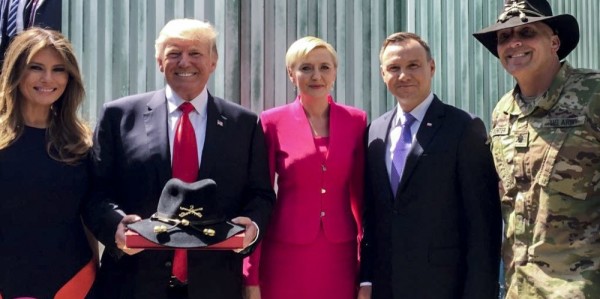

Poland, which has had a Russian boot on its windpipe for much of its history, wants U.S. troops to build a big military installation in its country — and the Pentagon is proceeding cautiously.
During his recent visit to the White House, Polish President Andrzej Duda invited the U.S. to permanently station troops in his country at a base that he dubbed “Fort Trump.”
The U.S. military is in the early stages of considering Poland’s offer and has not made any decisions yet, Defense Secretary James Mattis told reporters on Monday.
“This also has an impact on the alliance as a whole, the protection of Europe, we will obviously be engaging with other NATO nations in the alliance as we move forward,” Mattis said.
The new base would mean that U.S. troops would be permanently stationed on Russia’s border, which Russia has a tendency of crossing. Most of what is now Poland was absorbed into the Russian empire near the end of the 18th century. It regained its independence after World War I, but only briefly: In September 1939, the Nazis and Soviets invaded and partitioned the country between themselves. After World War II, Poland became a Soviet satellite state for 45 years.
Speaking at the White House, Duda said Poland has “a very important strategic location in Europe,” and that he is convinced that the U.S. has a vital national security interest in stationing troops there.
Right now, the Defense Department and Poland are looking at the land proposed for “Fort Trump,” Mattis said. The issues being looked at include how much land is available for firing ranges, maneuver ranges, and maintenance requirements.
“The first thing we have to do is look at what are they offering because then you would size up what it can actually hold and sustain,” Mattis explained. “We’re in the exploratory phase of doing just that. We’re still early in it but we’re working together and we’re greatly appreciative of the Polish offer.”

U.S. President Donald Trump poses with the U.S. Army cavalry stetson given to him by Lt. Col. Steven Gventer, Battle Group Poland commander, while the First Lady Melania and the Polish President Andrzej Duda and his wife, Agata, look on. July 6. 2017.DoD photo.
But Mattis pushed back when a reporter asked him if his comments indicated the U.S. military feels that it needs a permanent military installation in Poland.
“I’m not willing to say we need it,” Mattis said. “I’m just saying we’re exploring the offer and we have to know what it is before we can say if we need it or not.”
One complicating factor could be NATO’s 1997 agreement with Russia known as the Founding Act, in which the alliance vowed that it would not permanently station substantial combat forces in NATO members that used to belong to the Soviet Union or Warsaw Pact “in the current and foreseeable security environment.” For its part, Russia agreed to “exercise similar restraint in its conventional force deployments in Europe.”
However, the Founding Act is a political commitment, not a legally binding document, said former Ambassador Eric Edelman, who helped draft the agreement. Moreover, the security environment has changed considerably since 1997: Russia has since invaded Georgia and Ukraine, he said.
It is possible that the United States and Poland could reach a bilateral agreement on Fort Trump, but it would be better if the North Atlantic Council as a whole approved such a move, Edelman told Task & Purpose on Tuesday.
“We would be well advised to work with the allies because I think you could divide the alliance if you went ahead just purely bilaterally,” said Edelman, of the Center for Strategic and Budgetary Assessments in Washington, D.C. “But I don’t see any legal impediments to doing a bilateral deal with Poland, if someone wanted to do it.”
A NATO official declined to say if the Founding Act prevents NATO from permanently stationing troops in Poland and other newer NATO members that used to be within the Soviet Union’s sphere of influence.
“This specific proposal has not been discussed at NATO,” the official told T&P; in an email. “NATO already has a strong presence in Poland. This includes a multinational battlegroup led by the US, to deter any possible aggression.”
“The U.S. already deploys forces to a number of allies, including Poland, on a bilateral basis” he added. “So it is for Poland and the U.S. to look into the details of any further deployment.”
WATCH NEXT:
